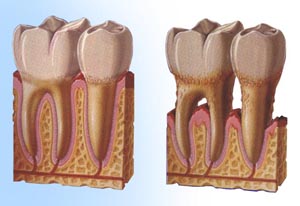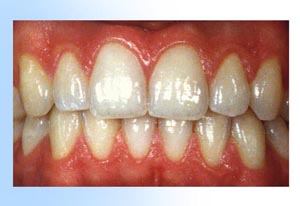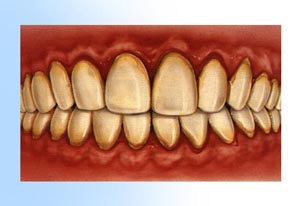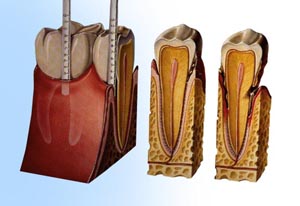Types of Gum Disease
 While there are many forms of gingival and periodontal diseases, the most common type are gingivitis and adult periodontitis. While there are many forms of gingival and periodontal diseases, the most common type are gingivitis and adult periodontitis.
Gingivitis is the earliest stage and affects only the gum tissue. At this stage, the disease is still reversible. If not treated, however, it may lead to a more sever condition.
Periodontitis is the more advanced stage of periodontal diseases. The gums, bone and other structures that support the teeth become damaged. Teeth can become loose and fall out-or may have to be removed. At this stage, the disease may require more complex treatment to prevent tooth loss.
Here is a step-by-step illustration of the process of gingivitis and periodontitis:
 1. Healthy gingival (gum tissue) and bone anchor the teeth firmly in place. 1. Healthy gingival (gum tissue) and bone anchor the teeth firmly in place.
|
|
 2. Gingivitis develops as toxins in plaque irritate the gums, making them red, tender, swollen and likely to bleed easily. 2. Gingivitis develops as toxins in plaque irritate the gums, making them red, tender, swollen and likely to bleed easily.
|
|
 3. Periodontitis occurs when toxins destroy the tissues that anchor the teeth in the bone. Gums become detached from the teeth, forming pockets that fill with more plaque. Tooth roots are exposed to plaque and become susceptible to decay and sensitive to cold and touch. 3. Periodontitis occurs when toxins destroy the tissues that anchor the teeth in the bone. Gums become detached from the teeth, forming pockets that fill with more plaque. Tooth roots are exposed to plaque and become susceptible to decay and sensitive to cold and touch.
|
|
 4. Advanced periodontitis is present when the teeth lose more attachment because the supporting bone is destroyed. Unless treated, the affected teeth frequently become loose and may fall out or require removal by a dentist. 4. Advanced periodontitis is present when the teeth lose more attachment because the supporting bone is destroyed. Unless treated, the affected teeth frequently become loose and may fall out or require removal by a dentist.
|
|
 Although gum diseases are caused by plaque, a number of other factors can increase the risk, severity, and speed of development of the condition. Although gum diseases are caused by plaque, a number of other factors can increase the risk, severity, and speed of development of the condition.
|
- People who smoke or chew tobacco are more likely to have gum diseases, and to have them more severely, than those who do not use any form of tobacco.
- Poorly fitting bridges, malocclusion (badly aligned teeth) or defective restorations (fillings), can all contribute to plaque retentions and increase the risk of developing gum diseases.
- Habits which place excessive biting forces on your teeth, such as clenching or grinding, may also accelerate the rate at which supporting bone is lost.
- Poor diet may cause gum diseases to progress more rapidly or increase the severity of the condition, according to some researchers. There is also some evidence than an unbalanced diet makes mouth tissues less resistant to infection.
- Pregnancy or use of oral contraceptives increases hormone levels which can cause gum tissues to react more sensitively to the toxins in plaque and accelerate growth or certain bacteria. The gums are more likely to become red, tender, and swollen and to bleed easily.
- Systemic diseases, such as AIDS or diabetes, can lower the tissues’ resistance to infection, making gum diseases more sever.
(Back to top)
|